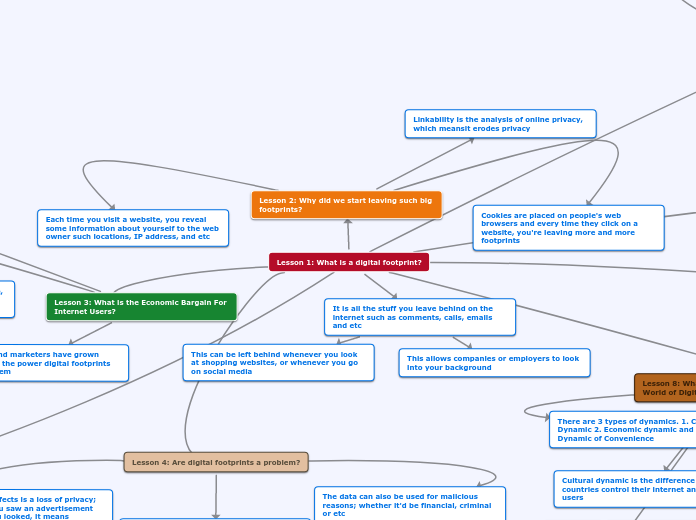Lesson 1: What is a digital footprint?
It is all the stuff you leave behind on the internet such as comments, calls, emails and etc
This allows companies or employers to look into your background
This can be left behind whenever you look at shopping websites, or whenever you go on social media
Lesson 2: Why did we start leaving such big footprints?
Each time you visit a website, you reveal some information about yourself to the web owner such locations, IP address, and etc
Cookies are placed on people's web browsers and every time they click on a website, you're leaving more and more footprints
Linkability is the analysis of online privacy, which meansit erodes privacy
Lesson 3: What is the Economic Bargain For Internet Users?
Advertisers and marketers have grown dependent on the power digital footprints have given them
Even if you pay a subscription for a service, it will not guarantee that your personal information is protected
The trade for you to view their content, advertisements, servers and networks is the essential economic bargain on the internet.
Lesson 4: Are digital footprints a problem?
One of the side effects is a loss of privacy; for example, if you saw an advertisement for something you looked, it means someone has been sharing your footprint with the advertisers
The data can also be used for malicious reasons; whether it'd be financial, criminal or etc
Looking into digital footprints can reduce public trust such the freedom of expression and freedom of action
Lesson 5: Do different devices makes digital footprints?
Smartphones location aware meaning by default, the location is always on and it knows where you are
Smartphones are also personal devices with all your information attached to it, meaning if someone were to look into your footprint, they would see everything including credit cards, passwords, and etc
Desktop computers primarily leave their footprints through web browsers
Lesson 6: How can I manage my digital footprint?
There are 4 layers of managing your digital footprint
1. Understanding basic issues
2. Develop your basic "hygiene habits"
3. Become a sophisticated user of the internet
4. Find and use privacy enhancing tools
Have a different credit card for online shopping and another for something else. Have a different email address for home and another for work. Be mindful on what you post on social media because it is more public than you think
Review information on how privacy tools and how to use them or review things such as how people get into your footprint and prevent that
Lesson 7: Who is tracking me and how do they do it?
There three main types of entities that are tracking you. Advertisers, Publishers and Aggregators
They are looking at what websites you click on and use your location to advertise things near where you lie.
These entities will still be able to guess who are based on your browser history
Lesson 8: What Dynamics are at Work in the World of Digital Footprints?
There are 3 types of dynamics. 1. Cultural Dynamic 2. Economic dynamic and 3. Dynamic of Convenience
Cultural dynamic is the difference of how countries control their internet and internet users
Economic dynamic gives service providers a strong incentive to collect data, even if you are good at managing your digital footprint, you still have to rely on this
Dynamic of convenience is the convenient use of the internet but people can invade your privacy if you use this.
Lesson 9: How does legislation affect digital footprint?
Some countries have laws that protect data such as medical records, financial records and etc
Some technology specific laws will improve the users browsing experience without having cookies
There are not many ways that can help protect footprints and if there is a way, it may work temporarily
